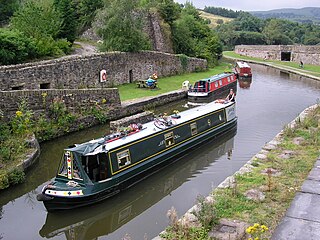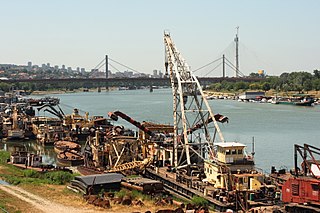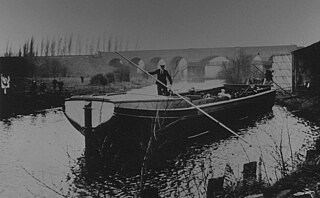Related Research Articles

A barge is a flat-bottomed boat, built mainly for river and canal transport of bulk goods. Originally barges were towed by draft horses on an adjacent towpath. Barges have changed throughout time. From 1967 to 1983 barges were considered a flat bottom boat that was nineteen feet in length or larger. Today, barges may be self-propelled, usually with a slow-revving diesel engine and a large-diameter fixed-pitch propeller. Otherwise, "dumb barges" must be towed by tugs, or pushed by pusher boats. Compared to a towed barge, a pusher system has improved handling and is more efficient, as the pushing tug becomes "part of the unit" and it contributes to the momentum of the whole.

A towpath is a road or trail on the bank of a river, canal, or other inland waterway. The purpose of a towpath is to allow a land vehicle, beasts of burden, or a team of human pullers to tow a boat, often a barge. This mode of transport was common where sailing was impractical due to tunnels and bridges, unfavourable winds, or the narrowness of the channel.

The Grand Union Canal in England is part of the British canal system. Its main line starts in London and ends in Birmingham, stretching for 137 miles (220 km) with 166 locks. It has arms to places including Leicester, Slough, Aylesbury, Wendover and Northampton.

A narrowboat is a particular type of canal boat, built to fit the narrow locks of the United Kingdom. The UK's canal system provided a nationwide transport network during the Industrial Revolution, but with the advent of the railways, commercial canal traffic gradually diminished and the last regular long-distance transportation of goods had virtually disappeared by 1970. However, some commercial traffic continued. From the 1970s onward narrowboats were gradually being converted into permanent residences or as holiday lettings. Today, approximately 6000 narrowboats are registered as 'permanent homes' on Britain's waterway system and represent a growing alternative community living on semi-permanent moorings or continuously cruising.
The Gloucester and Sharpness Canal is a canal in the west of England, between Gloucester and Sharpness; for much of its length it runs close to the tidal River Severn, but cuts off a significant loop in the river, at a once-dangerous bend near Arlingham. It was once the broadest and deepest canal in the world. The canal is 26.5 km long.

The Canal Museum, formerly known as the "National Waterways Museum Stoke Bruerne" and "The Canal Museum at Stoke Bruerne", is a canal museum located next to the Grand Union Canal just south of the Blisworth Tunnel, near the village of Stoke Bruerne in Northamptonshire. It is about 10 miles (16 km) north of Milton Keynes and 7 miles (11 km) south of Northampton near junction 15 of the M1 motorway.

A pusher, pusher craft, pusher boat, pusher tug, or towboat, is a boat designed for pushing barges or car floats. In the United States, the industries that use these vessels refer to them as towboats. These vessels are characterized by a square bow, a shallow draft, and typically have knees, which are large plates mounted to the bow for pushing barges of various heights. These boats usually operate on rivers and inland waterways. Multiple barges lashed together, or a boat and any barges lashed to it, are referred to as a "tow" and can have dozens of barges. Many of these vessels, especially the long distances, or long haul boats, include living quarters for the crew.

A riverboat is a watercraft designed for inland navigation on lakes, rivers, and artificial waterways. They are generally equipped and outfitted as work boats in one of the carrying trades, for freight or people transport, including luxury units constructed for entertainment enterprises, such as lake or harbour tour boats. As larger water craft, virtually all riverboats are especially designed and constructed, or alternatively, constructed with special-purpose features that optimize them as riverine or lake service craft, for instance, dredgers, survey boats, fisheries management craft, fireboats and law enforcement patrol craft.

The canals of the United Kingdom are a major part of the network of inland waterways in the United Kingdom. They have a varied history, from use for irrigation and transport, through becoming the focus of the Industrial Revolution, to today's role of recreational boating. Despite a period of abandonment, today the canal system in the United Kingdom is again increasing in use, with abandoned and derelict canals being reopened, and the construction of some new routes. Canals in England and Wales are maintained by navigation authorities. The biggest navigation authorities are the Canal & River Trust and the Environment Agency, but other canals are managed by companies, local authorities or charitable trusts.

The Droitwich Canal is a synthesis of two canals in Worcestershire, England; the Droitwich Barge Canal and the Droitwich Junction Canal. The Barge Canal is a broad canal which opened in 1771 linking Droitwich Spa to the River Severn at Hawford Bottom Lock, Claines. The Droitwich Junction Canal is a narrow canal, opened in 1854, which linked Droitwich to the Worcester and Birmingham Canal. Both were built to carry salt, and were abandoned in 1939. They have been the subject of a restoration plan since 1973, and the Barge Canal was officially reopened in 2010, while the Junction Canal reopened in July 2011. Following the opening of the canal, ownership transferred to the newly created Canal and River Trust

The New York State Canal System is a successor to the Erie Canal and other canals within New York. Currently, the 525-mile (845 km) system is composed of the Erie Canal, the Oswego Canal, the Cayuga–Seneca Canal, and the Champlain Canal. In 2014 the system was listed as a national historic district on the National Register of Historic Places in its entirety, and in 2016 it was designated a National Historic Landmark.

Woolhampton Lock is a lock on the Kennet and Avon Canal, in the village of Woolhampton in the English county of Berkshire. The lock has a rise/fall of 8 feet 11 inches (2.72 m) and is administered by the Canal and River Trust.

A hotel barge is a barge that has been built or converted to serve as a hotel or other kind of lodging. Hotel barges are generally found on rivers and canals in Europe, and may be used for river cruises or permanently moored in one place.

Brentford Dock in Brentford, west London, was a major trans-shipment point between the Great Western Railway (GWR) and barges on the River Thames. The building of Brentford Dock was started in 1855 and it was formally opened in 1859. The former dock yard was redeveloped in 1972 and is now Brentford Dock Marina and Brentford Dock Estate.

Perseverance IV is a preserved Wey barge, moored at Dapdune Wharf on the River Wey in Surrey, England. She was the final barge to leave that surviving main boatyard on the river. She did so in 1966 and is on the National Register of Historic Ships under registration number 2080, outside of the National Historic Fleet.

The Canal & River Trust (CRT), branded as Glandŵr Cymru in Wales, holds the guardianship of 2,000 miles of canals and rivers, together with reservoirs and a wide range of heritage buildings and structures, in England and Wales. Launched on 12 July 2012, the Trust took over the responsibilities of the state-owned British Waterways.

Lady of the Lea is a spritsail Thames sailing barge, the last such barge to be built in England. She was built in 1931 to carry explosives from Waltham Abbey Royal Gunpowder Mills on the River Lea to Woolwich Arsenal on the River Thames. The barge was later sold and rebuilt. She currently operates as a private yacht and competes in Thames sailing barge matches.

A widebeam is a canal boat built in the style of a British narrowboat but with a beam of 2.16 metres or greater.

Word on the Water is a bookshop based on a 100-year-old Dutch canal boat that normally resides on Regent's Canal in the King's Cross area, London, although it can be found in other places along the London canal network.
References
- "All craft great and small". Canal & River Trust. 28 January 2019. Retrieved 20 January 2020.